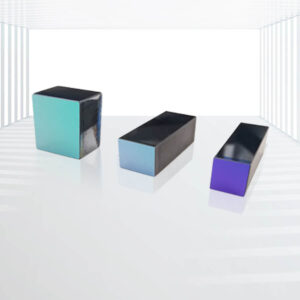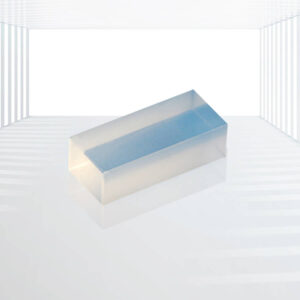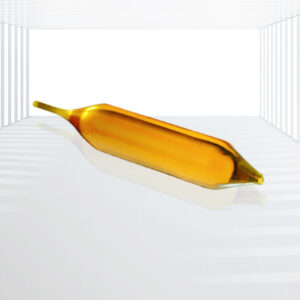Wollaston Prism
High Polarization Purity: Wollaston Prism is capable of efficiently separating incident light into two orthogonally polarized beams of light (commonly referred to as o-light and e-light) with extremely high polarization purity. This means that the polarization state of the outgoing light is very pure and contains almost no cross-polarization components.
Wide spectral range: Due to its material properties, Wollaston Prism can work over a wide spectral range, covering different wavelengths from ultraviolet to infrared. This makes it suitable for a wide range of optical systems and applications.
High transmittance:The well-designed Wollaston Prism has a high transmittance that minimizes the loss of light as it passes through the prism and improves the efficiency of light utilization.
Structurally stable: Wollaston Prism is usually formed by bonding two orthogonal birefringence crystal prisms, which are relatively stable and able to maintain stable performance in a variety of environments.
Adjustable angle: The Wollaston Prism available in the market has different divergence angles of the outgoing light, and users can choose the appropriate divergence angle according to their actual needs to meet different application needs.
Applications: Spectral analysis, Laser Technology, Optical Measurements, Microscopy Techniques, Other areas, etc.
Wollaston Prism consists of two right-angled, triangular crystals of the same material bonded together to form a parallel plate. The optical axes of the two crystals are perpendicular to each other, and the optical axis of the first crystal is parallel to the plane of incidence. This structure allows Wollaston Prism to decompose an incident light wave into two light waves traveling in different directions and orthogonal in the direction of polarization.
Specifications:
| Item | MgF2 | Alpha-BBO | Quartz | YVO4 |
| Wavelength Range | 130-7000nm | 190-3500nm | 200-2300nm | 500-4000nm |
| Extinction Ratio | <5×10-5 | <5×10-6 | <5×10-5 | <5×10-6 |
| Surface Quality | 20/10 S/D | |||
| Beam Deviation | < 3 arc minutes | |||
| Wavefront Distortion | <λ/4@633nm | |||
| Damage Threshold | >200MW/cm2@1064nm, 20ns, 20Hz | |||
| Coating | P Coating or AR Coating | |||
| Mount | Black Anodized Aluminum | |||
Features:
- High Polarization Purity: Wollaston Prism is capable of efficiently separating incident light into two orthogonally polarized beams of light (commonly referred to as o-light and e-light) with extremely high polarization purity. This means that the polarization state of the outgoing light is very pure and contains almost no cross-polarization components.
- Wide spectral range: Due to its material properties, Wollaston Prism can work over a wide spectral range, covering different wavelengths from ultraviolet to infrared. This makes it suitable for a wide range of optical systems and applications.
- High transmittance:The well-designed Wollaston Prism has a high transmittance that minimizes the loss of light as it passes through the prism and improves the efficiency of light utilization.
- Structurally stable: Wollaston Prism is usually formed by bonding two orthogonal birefringence crystal prisms, which are relatively stable and able to maintain stable performance in a variety of environments.
- Adjustable angle: The Wollaston Prism available in the market has different divergence angles of the outgoing light, and users can choose the appropriate divergence angle according to their actual needs to meet different application needs.
Applications:
- Spectral analysis:In the field of spectroscopy, Wollaston Prism is used to separate incident light into beams of different polarization states for more precise spectral measurements and analysis.
- Laser Technology:In laser technology, Wollaston Prism is often used for polarization control and separation of laser beams, and is an important component in building high-performance laser systems.
- Optical Measurements:In the field of optical measurement, Wollaston Prism can be used to accurately measure the polarization state and phase difference of light, which is of great significance for improving the measurement accuracy.
- Microscopy Techniques: In microscopy techniques, specifically differential interference contrast microscopy (DIC microscopy), Wollaston Prism or its modifications (e.g., Nomarski prisms) are used to produce differential interference images that enhance the contrast and clarity of the sample.
- Other areas: In addition, Wollaston Prism is also widely used in optical communication, optical sensing, optical information processing and other fields, providing strong support for the development of these fields.
Wollaston Prism plays a key role in several fields as an important optical component. Its unique structure and working principle enable it to efficiently separate and control the polarization state of light, providing strong support for optical research and application.










